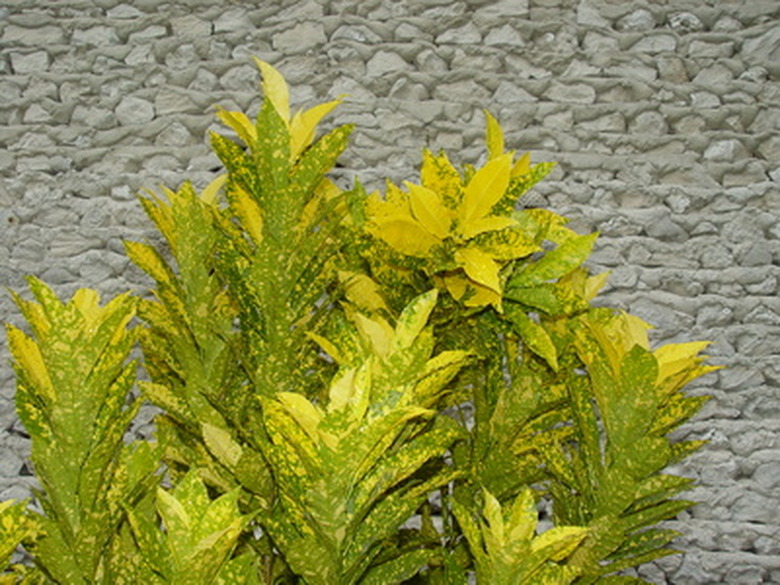How To Care For A Croton Gold Star Codiaeum Plant
The croton plant (Codiaeum variegatum) is a sun-loving tropical shrub—grow crotons only in USDA hardiness zones 9B through 11—that's best known for its colorful foliage. The "Gold Star" variety has green leaves speckled with yellow and can add instant warmth to your backyard. Take proper care of your Gold Star croton to keep its foliage healthy and ensure healthy growth for years.
Step 1
Plant the Gold Star croton outdoors directly in the soil in a well-drained area that receives about five or six hours of direct sunlight. Alternatively, place the plant in a five-gallon pot—crotons grow quickly and will require several repottings if you choose this method—filled with a sandy soil mix made up of three parts peat moss and one part sand.
Step 2
Water the croton plant. Crotons lose more moisture through their leaves than most other types of plants, according to the University of Florida. Water daily if it's potted, or every couple of days if it's grown in the ground. Gauge the plant's water needs by observing its leaves. Find the rate of water that your specific soil and climate requires by decreasing watering until you notice slight wilting.
- The croton plant (Codiaeum variegatum) is a sun-loving tropical shrub—grow crotons only in USDA hardiness zones 9B through 11—that's best known for its colorful foliage.
- Alternatively, place the plant in a five-gallon pot—crotons grow quickly and will require several repottings if you choose this method—filled with a sandy soil mix made up of three parts peat moss and one part sand.
Step 3
Feed the Gold Star croton. Use a standard shrub fertilizer with a nutrient ratio of 3-1-2. Apply once every two to three months in accordance with the fertilizer's label—potency varies by product.
Step 4
Control pests on your croton plant. Crotons are rarely attacked by insects, but the plants can sometimes be afflicted with mealybugs and mites. If you have mealybugs, spray the plant with a dimethoate-, flonicamid- or imidacloprid-based insecticide. If you have mites, use a bifenthrin- or bifenazate-based insecticide. Apply the insecticide according to its label, as chemical concentrations and toxicity vary widely by brand.
- Feed the Gold Star croton.
- If you have mites, use a bifenthrin- or bifenazate-based insecticide.
Step 5
Harvest the Gold Star plant's foliage, if you plan to use it in flower arrangements and the like. Grab a leaf and twist it to snap it off the croton's branch. Store the leaves in your refrigerator until you use them.
Tip
Gold Star crotons, like all crotons, have a wide shape. If planting more than one croton, plant them approximately 36 inches apart.
Warning
Too much fertilizer will cause your Gold Star croton's yellow coloring to lose some of its brightness.
Things Needed
- Pot
- Peat moss
- Sand
- Water
- Shrub fertilizer
- Insecticide (optional)
- Refrigerator (optional)
References
- "Landscaping with Tropical Plants"; Monica Brandies; 2004
- University of Florida: Croton Production and Use
